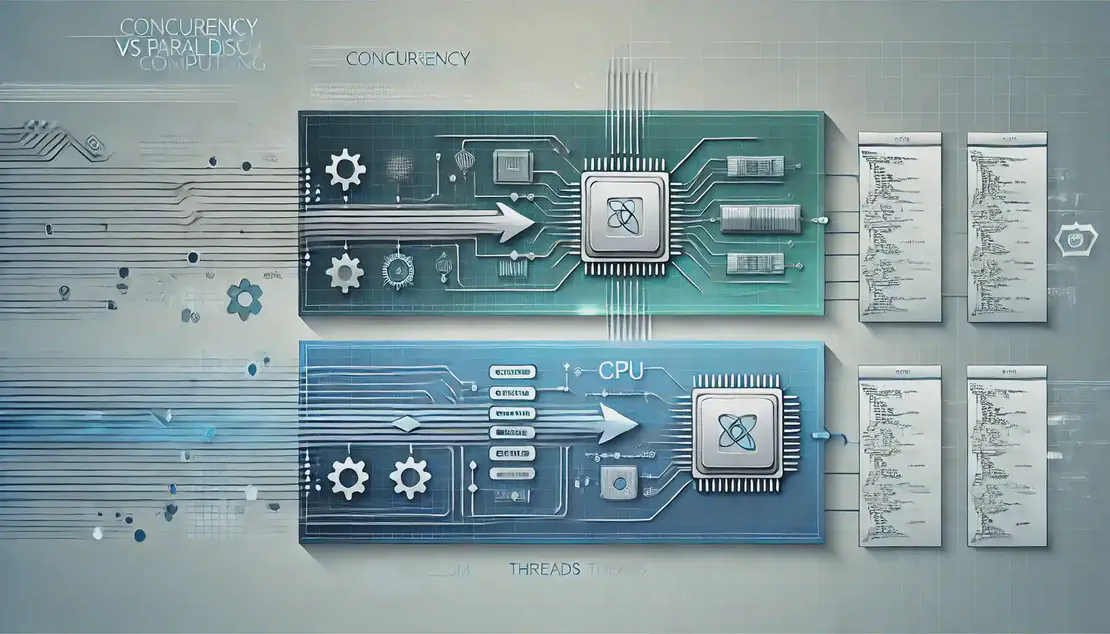
Concurrency vs Parallelism in Computing
- Vipul Kumar
- Concurrency , Parallelism , Computing , Performance
- December 19, 2024
Table of Contents
🔄 Concurrency — Concurrency involves managing multiple tasks that can start, run, and complete in overlapping time periods. It is about dealing with many tasks at once, but not necessarily executing them simultaneously.
⚙️ Parallelism — Parallelism is the simultaneous execution of multiple tasks or subtasks, typically requiring multiple processing units. It is about performing many tasks at the same time.
🖥️ Hardware Requirements — Concurrency can be achieved on a single-core processor through techniques like time-slicing, whereas parallelism requires a multi-core processor or multiple CPUs.
🔀 Task Management — Concurrency is achieved through interleaving operations and context switching, creating the illusion of tasks running simultaneously. Parallelism divides tasks into smaller sub-tasks that are processed simultaneously.
🧩 Conceptual Differences — Concurrency is a program or system property, focusing on the structure and design to handle multiple tasks. Parallelism is a runtime behavior, focusing on the execution of tasks simultaneously.
Concurrency Explained
🔄 Definition — Concurrency refers to the ability of a system to handle multiple tasks at once, but not necessarily executing them simultaneously. It involves managing the execution of tasks in overlapping time periods.
🕒 Time-Slicing — In single-core systems, concurrency is achieved through time-slicing, where the CPU switches between tasks rapidly, giving the illusion of simultaneous execution.
🔀 Context Switching — Concurrency relies on context switching, where the CPU saves the state of a task and loads the state of another, allowing multiple tasks to progress.
🧩 Program Design — Concurrency is a design approach that allows a program to be structured in a way that can handle multiple tasks efficiently, often using threads or asynchronous programming.
🔍 Use Cases — Concurrency is useful in applications where tasks can be interleaved, such as handling multiple user requests in a web server or managing I/O operations.
Parallelism Explained
⚙️ Definition — Parallelism involves executing multiple tasks or subtasks simultaneously, typically requiring multiple processing units or cores.
🖥️ Multi-Core Processors — Parallelism is often achieved using multi-core processors, where each core can handle a separate task, leading to true simultaneous execution.
🔄 Task Division — Tasks are divided into smaller sub-tasks that can be processed in parallel, increasing computational speed and throughput.
🔍 Use Cases — Parallelism is ideal for tasks that can be broken down into independent units, such as scientific computations, data processing, and graphics rendering.
🧩 System Design — Parallelism requires careful design to ensure tasks are independent and can be executed without interference, often using parallel programming models like MPI or OpenMP.
Comparative Analysis
🔄 Concurrency vs Parallelism — Concurrency is about managing multiple tasks in overlapping time periods, while parallelism is about executing tasks simultaneously.
🖥️ Hardware Requirements — Concurrency can be achieved on a single-core processor, whereas parallelism requires multiple cores or processors.
🔀 Execution — Concurrency involves interleaving tasks, while parallelism involves dividing tasks into independent sub-tasks for simultaneous execution.
🧩 Design vs Execution — Concurrency is a design property focusing on task management, while parallelism is a runtime behavior focusing on task execution.
🔍 Debugging — Debugging concurrent systems can be challenging due to non-deterministic task execution, while parallel systems require careful synchronization to avoid race conditions.
Read On LinkedIn | WhatsApp | DEV TO | Medium
Follow me on: LinkedIn | WhatsApp | Medium | Dev.to | Github
Concurrency vs Parallelism - Manning Publications
freecontent.manning.com
Concurrency vs. Parallelism — A brief view
medium.com
What is the difference between concurrency and parallelism?
stackoverflow.com
Difference between Concurrency and Parallelism
geeksforgeeks.org
Concurrency vs. Parallelism
jenkov.com
Concurrency Vs Parallelism!
youtube.com
Concurrency vs parallelism: the main differences
oxylabs.io
Concurrency Vs Parallelism: Definitions & Examples
studysmarter.co.uk
Concurrency vs Parallelism | Baeldung on Computer Science
baeldung.com

